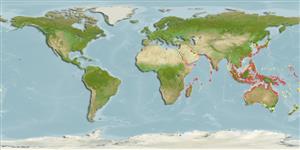Teleostei (teleosts) >
Gobiiformes (Gobies) >
Gobiidae (Gobies) > Amblyopinae
Etymology: Paratrypauchen: The generic name is derived from the Greek Para, meaning beside or near, alluding to the similarity with Trypauchen. The gender is masculine.
More on author: Bleeker.
Environment: milieu / climate zone / depth range / distribution range
Ecology
Marine; brackish; demersal; depth range 0 - 10 m (Ref. 86942). Tropical
Indo-West Pacific: Natal to Kenya, through India, Indonesia to the Philippines. Also known from Wakayama, Niigata and Kumamoto Prefecture (Japan), the Korean Peninsula, China, and Malaysia (Ref. 559). Also from Singapore, Mozambique (Ref. 92840).
Size / Weight / Age
Maturity: Lm ? range ? - ? cm
Max length : 18.0 cm TL male/unsexed; (Ref. 4343)
Inhabits soft mud bottoms, river mouths areas near mangrove forests; omnivore feeding on benthic invertebrates like crustaceans (Ref. 92840). Burrows in mud or shingle areas in inshore and estuarine waters (Ref. 4343, 11230).
Life cycle and mating behavior
Maturity | Reproduction | Spawning | Eggs | Fecundity | Larvae
Maugé, L.A., 1986. Gobiidae. p. 358-388. In J. Daget, J.-P. Gosse and D.F.E. Thys van den Audenaerde (eds.) Check-list of the freshwater fishes of Africa (CLOFFA). ISNB, Brussels; MRAC, Tervuren; and ORSTOM, Paris. Vol. 2. (Ref. 4343)
IUCN Red List Status (Ref. 130435: Version 2024-2)
Threat to humans
Harmless
Human uses
Fisheries: minor commercial; aquarium: commercial
Tools
Special reports
Download XML
Internet sources
Estimates based on models
Preferred temperature (Ref.
123201): 23.6 - 29.2, mean 28.4 °C (based on 2768 cells).
Phylogenetic diversity index (Ref.
82804): PD
50 = 1.0000 [Uniqueness, from 0.5 = low to 2.0 = high].
Bayesian length-weight: a=0.00417 (0.00263 - 0.00661), b=2.90 (2.76 - 3.04), in cm total length, based on LWR estimates for this species & (Sub)family-body (Ref.
93245).
Trophic level (Ref.
69278): 3.7 ±0.4 se; based on size and trophs of closest relatives
Resilience (Ref.
120179): Medium, minimum population doubling time 1.4 - 4.4 years (Preliminary K or Fecundity.).
Fishing Vulnerability (Ref.
59153): Low vulnerability (10 of 100).
